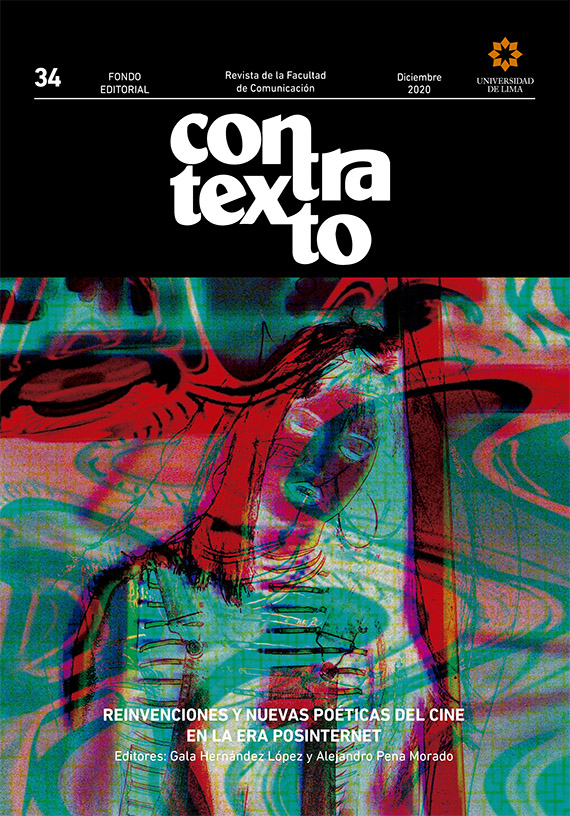Appropriation cinema at the dawn of the digital age: reflections from Harun Farocki’s work
DOI:
https://doi.org/10.26439/contratexto2020.n034.4865Keywords:
documentary, film essay, cinema, media studies, found footageAbstract
Harun Farocki's work (1944-2014) has spanned for more than five decades, and has dealt primarily with the image, its meanings, its relationship with the mass ideology, and the possibilities and limits of its automation and mechanization in the digital age. Through the found footage technique, Farocki has established throughout his career different analytical strategies that have allowed him, through his film works, to propose an exhaustive review and criticism of the image and its implications. This essay seeks to propose reflections, based on Farocki's work, about the politics of the image, the relationship with the author / producer and its role in ideological, political and social spheres.
Downloads
References
Alter, N. (2004). The political im/perceptible: Farocki’s Images of the world and the inscription of war. En T. Elsaesser. (Ed.), Harun Farocki (pp. 211-234). Amsterdam University Press.
Althusser, L. (1971). Ideología y aparatos ideológicos del Estado. Oveja Negra.
Baudrillard, J. (1993). Cultura y simulacro. Kairos.
Benjamin, W. (1989). Discursos Interrumpidos I. Taurus.
Benjamin, W. (1998). Understanding Brecht. Verso.
Blümlinger, C. (2004). Slowly forming a thought while working on image. En T. Elsaesser. (Ed.), Harun Farocki (pp. 163-175). Amsterdam University Press.
Deleuze, G. (1989). Cinema 2. The Time-Image. University of Minnesota Press.
Didi-Huberman, G. (2004). Imágenes pese a todo. Memoria visual del Holocausto. Paidós.
Didi-Huberman, G. (2009). How to open your eyes. Archive Harun Farocki Filmproduktion.
Elsaesser, T. (2004). Political filmmaking after Brecht: Harun Farocki, for example. En T. Elsaesser. (Ed.), Harun Farocki (pp. 133-153). Amsterdam University Press.
Elsaesser, T. (2008). Harun Farocki: Filmmaker, artist, media theorist. Afterall: A journal of art, context and equity, 11(Spring/Summer), 54-63.
Elsaesser, T. & Farocki, H. (2004). Making the world superfluous: An interview with Harun Farocki. En T. Elsaesser. (Ed.), Harun Farocki (pp. 177-189). Amsterdam University Press.
Ernst, W. & Farocki, H. (2004). Towards an archive for visual concepts. En T. Elsaesser. (Ed.), Harun Farocki (pp. 261-286). Amsterdam University Press.
Farocki, H. & Wilson, P. (1993). The industrialization of thought. Discourse 15(3), 76-77. https://www.jstor.org/stable/41389286
Foucault, M. (1975). Vigilar y castigar. El nacimiento de la prisión. Siglo XXI.
Hüser, R. & Farocki, H. (2004). Nine minutes in the yard: A conversation with Harun Farocki. En T. Elsaesser. (Ed.), Harun Farocki (pp. 133-153). Amsterdam University Press.
Kramer, S. (2014). Reiterative reading: Harun Farocki’s approach to the footage from Westerbork transit camp. New German Critique, 123(Fall), 35-55. https://www.jstor.org/stable/43910632
Kristeva, J. (1978). Semiótica 1. Fundamentos.
Pantenburg, V. (2015). Le film qui pense. Image, theory, practice. En Farocki/Godard. Film as Theory (pp. 33-72). Amsterdam University Press. https://doi.org/10.5117/9789089648914
Steetskamp, J. (2008). Found footage, performance, reenactment: A case for repetition. En J. Kooijman, P. Pisters & W. Strauven, Mind the Screen (pp. 333-344). Amsterdam University Press.
Wahlberg, M. (2008). The trace in contemporary media. En M. Wahlberg. (Ed.), Documentary Time. Film and Phenomenology (pp. 118-143). University of Minnesota Press.
Downloads
Published
Issue
Section
License
All of the works published are licensed under a CC BY 4.0 Creative Commons Attribution license. (updated on March 1st 2021)
The content of the journal may be shared in any material or format. The content may be adapted, contributed upon and transformed. Both possibilities are only permitted in so far as they complete the following conditions:
- Attribution: Credit must be given where it is due, a link to the license must be provided and changes, if made, must be indicated. This should be done in the manner deemed appropriate, without suggesting that the licensor promotes you or your use of the material.
Ownership rights
The patrimonial rights for Contratexto are published under a Creative Commons BY 4.0 license, allowing authors to keep the patrimonial rights to their work without restrictions.
If a work published in Contratexto were to be copied, distributed, spread, or any other activities contemplated in the aforementioned license, the author(s) and the journal must be mentioned visibly and expressly.
Self-archive
This journal allows and encourages authors to post items submitted to the journal on personal websites or institutional repositories both prior to and after publication, while providing bibliographic details that credit, if applicable, its publication in this journal.


